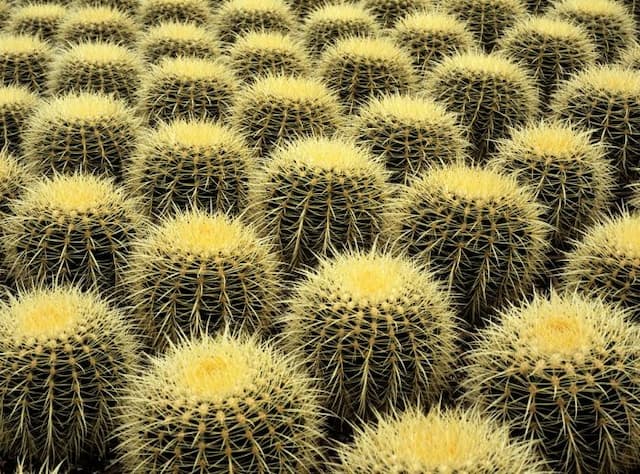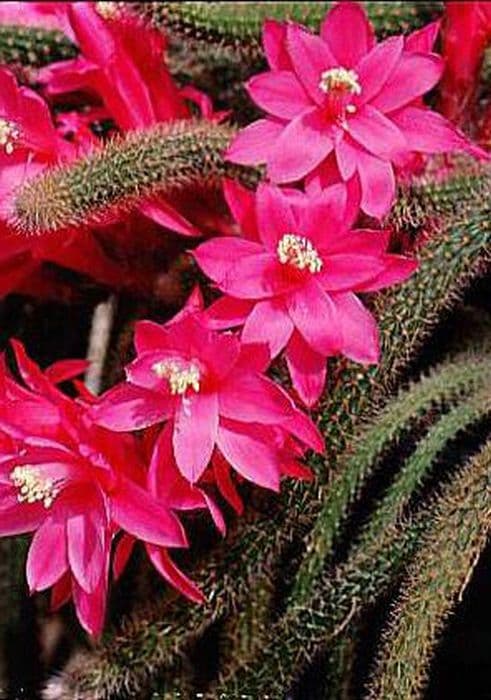Bunny Ear Cactus Opuntia microdasys 'Albata'
ABOUT
The Opuntia microdasys 'Albata', commonly known as Bunny Ears Cactus, is a distinctive succulent that's easily identified by its pad-like stems, which resemble the ears of a rabbit. These stems are typically a pale green to yellow-green color and have a fleshy, rounded yet flattened shape. The pads grow in a branching pattern extending out from the base of the plant, often forming a dense cluster. One of the most notable features of the Bunny Ears Cactus are the tufts of glochids, which are small, barb-like bristles that are grouped in dot-like clusters all over the pads. These glochids are either white or yellow in color, creating a polka-dot effect against the green backdrop of the stems, and they easily detach from the plant. While they give the plant a soft and fuzzy appearance, they are actually quite irritating to the skin and should be handled with care. Flowers or fruits are rarely seen when cultivated indoors. When they do occur, the flowers are usually yellow and small, and they may be followed by small purple fruits. However, it is primarily the unique shape and texture of the stems, covered in the eye-catching white bristles, that make the Bunny Ears Cactus a popular ornamental plant. Its distinctive pads and lack of large spines (aside from the small glochids) add to its charm, making it a striking addition to a succulent collection or as a stand-alone feature in a pot or garden setting.
About this plant
 Names
NamesFamily
Cactaceae.
Synonyms
Bunny Ears Cactus, Angel's Wings, Polka-Dot Cactus.
Common names
Opuntia microdasys 'Alba', Cactus microdasys.
 Toxicity
ToxicityTo humans
The Bunny Ear Cactus is not considered toxic if ingested. However, the tiny hair-like spines called glochids can cause irritation to the skin and mucous membranes. If the cactus is handled and the glochids are transferred to the mouth, throat, or eyes, they can cause discomfort, pain, and potentially lead to infection if not promptly and carefully removed. There is no inherent plant poison or toxicity causing symptoms from ingestion, but mechanical injury and secondary infection are possible consequences of handling or accidental ingestion of the spines.
To pets
The Bunny Ear Cactus is similarly not considered poisonous to pets if ingested, but the primary concern is the presence of small, barbed spines called glochids. These can cause irritation and pain if they come into contact with or become embedded in the pet's skin, paws, or mouth. Ingesting parts of the cactus with glochids can lead to oral irritation, drooling, pawing at the face, or difficulty swallowing. Mechanical injury to the mouth and throat, as well as potential infection, are the main consequences to be concerned with, rather than poisoning from the plant material itself.
 Characteristics
CharacteristicsLife cycle
Perennials
Foliage type
Evergreen
Color of leaves
Green
Flower color
Yellow
Height
2 feet [60 cm]
Spread
4 feet [120 cm]
Plant type
Cactus
Hardiness zones
9
Native area
Mexico
Benefits
 General Benefits
General Benefits- Low Maintenance: Bunny ears cactus requires minimal care, making it an ideal choice for busy or novice plant owners.
- Drought-tolerant: It can survive with little water, making it perfect for water-wise gardens in arid climates.
- Unique Aesthetic: With its distinctive ear-like pads, the bunny ears cactus adds an interesting visual element to any space.
- Pest Resistant: This plant is not prone to many pests, reducing the need for chemical pesticides.
- Soil Adaptability: It can grow in a range of soil types, provided they are well-draining.
- Suitable for Containers: Fits well in pots, making it ideal for indoor spaces and small outdoor areas.
- Long Living: As a perennial, the bunny ears cactus can live for many years with proper care.
- Propagation: Easy to propagate from cuttings, facilitating the creation of new plants.
- Non-toxic to Pets: Unlike some cacti, it does not contain toxic components that would harm pets if accidentally ingested.
- Sun-loving: Thrives in full sun conditions, perfect for sunny windowsills or desert landscapes.
 Medical Properties
Medical PropertiesThis plant is not used for medical purposes.
 Air-purifying Qualities
Air-purifying QualitiesThis plant is not specifically known for air purifying qualities.
 Other Uses
Other Uses- Decorative Jewelry Holder: The bunny ears cactus can be used to carefully hang lightweight earrings or bracelets between its spines, giving a unique aesthetic to jewelry organization.
- Artistic Inspiration: Its distinctive pad shape and arrangement can inspire artists and decorators, serving as a subject or model for drawing, painting, and other art forms.
- Photography Prop: Bunny ears cactus can be used as an intriguing and visually appealing prop in product photography, particularly in the fashion and design industries.
- Feng Shui Plant: Some believe that like other cacti, the bunny ears could be placed in specific areas of the home to bring positive energy according to feng shui principles.
- Sound Dampening: While not its primary feature, a collection of bunny ears cacti in a room could potentially absorb and diffuse sound to a small extent, aiding in the acoustics of a space.
- Theme Parties: It can serve as a perfect centerpiece or decor item for Western or desert-themed events, enhancing the ambiance with its authentic appearance.
- Handcrafts Material: The structure of the cactus can be incorporated into handcrafted items such as terrariums or combined with other materials to create unique craft projects.
- Education Tool: This cactus could be used in educational settings as a hands-on tool for teaching about desert plants, adaptation, and plant care.
- Seasonal Decoration: Bundles of bunny ears cactus pads can be creatively decorated and themed for use as ornaments during holidays like Christmas or Halloween.
- Stop-motion Animation: Because of its unique and quirky look, the bunny ears cactus can serve as an interesting object in stop-motion animation projects.
Interesting Facts
 Feng Shui
Feng ShuiThe Bunny Ears Cactus is not used in Feng Shui practice.
 Zodiac Sign Compitability
Zodiac Sign CompitabilityThe Bunny Ears Cactus is not used in astrology practice.
 Plant Symbolism
Plant Symbolism- Resilience: As a species of cactus, the Opuntia microdasys 'Albata', commonly known as the "Bunny Ear Cactus," is able to thrive in arid and harsh conditions, symbolizing the ability to endure and overcome difficult environments.
- Protection: The cactus is equipped with prickles, which can represent a form of natural defense and thus symbolize protection against adversity.
- Adaptation: The Bunny Ear Cactus has adapted to store water, allowing it to survive in desert climates. This characteristic symbolizes the importance of adaptation to changing circumstances.
- Conservation: As a plant that uses water efficiently, it represents conservation and the prudent use of resources.
- Independence: The cactus often grows and thrives without much help, embodying independence and self-sufficiency.
- Warmth and Affection: Despite its prickly exterior, the playful shape of the Bunny Ear Cactus can symbolize warmth and affection, perhaps indicating that even in tough exteriors there is the possibility of kindness.
 Water
WaterBunny Ears cactus requires infrequent watering. It's crucial to allow the soil to dry out completely before watering again. Typically, during the active growing season in spring and summer, watering every 1-2 weeks should suffice, using approximately 8-16 ounces of water, depending on the pot size. In the fall and winter, reduce watering frequency to once a month or less. Overwatering can lead to root rot, so it's important to err on the side of underwatering rather than giving too much.
 Light
LightBunny Ears cactus thrives in bright, indirect light or filtered sunlight. It can tolerate direct sunlight but should be acclimatized to prevent sunburn. A south or east-facing window where it receives plenty of light without being exposed to the harsh afternoon sun is ideal for this plant. Adequate light contributes to the cactus's health and flowering potential.
 Temperature
TemperatureBunny Ears cactus prefers warm temperatures, ideally between 70°F and 100°F during the day. Nighttime temperatures should not drop below 50°F. It can withstand short periods of colder weather, but prolonged exposure to temperatures below 50°F can be harmful. The cactus will appreciate being kept away from cold drafts and heating vents that can cause drastic temperature changes.
 Pruning
PruningBunny Ears cactus may need occasional pruning to remove damaged or diseased pads and to maintain its shape. Pruning is best done in the spring or early summer, when the plant is actively growing. Use a pair of clean, sharp scissors or pruning shears, and wear gloves to protect your hands from the tiny, hair-like spines. Pruning can also help stimulate new growth and improve airflow around the plant.
 Cleaning
CleaningAs needed
 Soil
SoilThe Bunny Ear Cactus prefers a well-draining soil mix, with a pH level around 6.0 to 7.5. An ideal mix can be created using 2 parts potting soil, 1 part coarse sand, and 1 part perlite or pumice. Amend the mix with some fine-grade fir bark to improve drainage. Regular cactus mix from garden centers usually works well if additional amendments are not feasible.
 Repotting
RepottingThe Bunny Ear Cactus should be repotted every 2 to 3 years to refresh the soil and accommodate its growth. It's best to repot during the active growing season, usually in spring or early summer. If the cactus shows signs of being root-bound or the soil is deteriorating, it may need more frequent repotting.
 Humidity & Misting
Humidity & MistingBunny Ear Cacti thrive in dry environments and do not require high humidity levels. These cacti are well-suited to the average indoor humidity levels found in most homes. To provide optimal conditions, aim for humidity levels between 10% and 30%.
 Suitable locations
Suitable locationsIndoor
Place Bunny Ear Cactus in bright, indirect light indoors.
Outdoor
In full sun to partial shade, well-draining soil, protect from frost.
Hardiness zone
9-11 USDA
 Life cycle
Life cycleOpuntia microdasys 'Albata', commonly known as the Bunny Ear Cactus, begins its life cycle as a seed, which when provided with the right conditions of warmth and minimal moisture, will germinate. Upon germination, a small cactus pad begins to develop, equipped with tiny glochids, or barbed bristles, instead of traditional spines. As the cactus matures, more pads grow from the areoles, which are the cactus's nodes, creating a characteristic branching structure that resembles bunny ears. Over time, these pads thicken and the cactus expands both vertically and horizontally. The Bunny Ear Cactus may occasionally bloom with yellow flowers in the spring or summer if it receives enough light, although flowering is less common in cultivation. After several years, it may reach a considerable size and can propagate asexually by pad segments that fall off and root to form new plants, continuing the life cycle.
 Propogation
PropogationPropogation time
Spring to Summer
The Bunny Ear Cactus, commonly known as Opuntia microdasys 'Albata', is best propagated using pad division, a technique that is most effective during the warm months from late spring to early summer. To propagate, a healthy pad should be carefully twisted off from the main plant and allowed to callous over for a few days until the cut surface is dry. Afterwards, the severed end is placed about 1 inch deep into a pot filled with a mixture of sand and potting soil. It should be watered sparingly to prevent rot and kept in a bright location, ensuring it receives indirect sunlight. Roots typically develop within a few weeks, after which watering can be gradually increased as the plant establishes itself.









